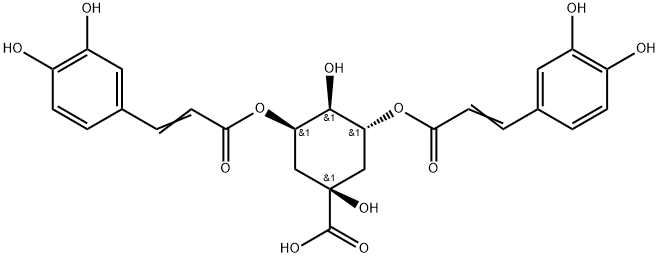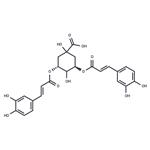Description
3,5-Dicaffeoylquinic acid (3,5-DCQA) is a natural phenolic compound that has been found in
L. japonica,
I. kaushue, and other plants. It has antioxidant, anti-inflammatory, and antiviral biological activities. 3,5-DCQA scavenges 2,2-diphenyl-1-picrylhydrazyl (DPPH; ) radicals in a cell-free assay (IC
50 = 71.8 μM) and inhibits superoxide production in human neutrophils activated by N-formyl-Met-Leu-Phe (fMLF) and cytochalasin B (IC
50 = 1.92 μM). It inhibits HIV-1 integrase 3''-end processing, strand transfer, and disintegration in a cell-free assay (IC
50s = 0.33, 0.34, and 0.66 μg/ml, respectively) and inhibits HIV-1-induced cytotoxicity in MT-2 cells (ED
50 = 1 μg/ml).
In vivo, 3,5-DCQA (25 mg/kg) protects mice from acute lung injury induced by LPS and decreases neutrophil count in bronchoalveolar lavage fluid (BALF).
Definition
ChEBI: 3,5-di-O-caffeoyl quinic acid is a carboxylic ester that is the diester obtained by the condensation of the hydroxy groups at positions 3 and 5 of (-)-quinic acid with the carboxy group of trans-caffeic acid. Isolated from Brazilian propolis and Suaeda glauca, it exhibits hepatoprotective and cytotoxic activities. It has a role as a metabolite, a hepatoprotective agent and an antineoplastic agent. It is a cyclitol carboxylic acid and a carboxylic ester. It is functionally related to a (-)-quinic acid and a trans-caffeic acid.


